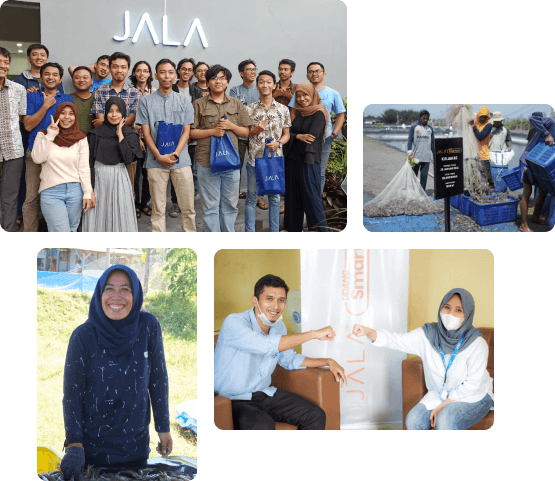
Feed is one of the main issues that bother shrimp farming the most frequently. To support shrimp growth and survival, feed must contain protein, carbohydrates, fats, vitamins, and minerals. On the other hand, about 60-70% of shrimp farming production costs are used to purchase feed. The increase in fish meal price as a raw material for making shrimp feed without being followed by an increase in shrimp selling price is the main issue in shrimp farming.
To reduce production costs, alternative ingredients are needed to replace fish meal in shrimp feed. One of the local alternative raw materials that contain complete nutrition for shrimp feed is maggot. Maggot can be processed into maggot flour (mag meal) as raw material for shrimp feed to reduce feed production costs. In addition, maggot cultivation utilizes organic waste as a source of feed for maggot larvae. As a result, it becomes a solution to overcome the organic waste problem in the community.
Shrimp Feed and Eating Habits
Shrimp are omnivorous scavengers, which means they consume everything (animals and plants), including carcasses. Shrimp forage at the bottom of the water, have diurnal and nocturnal habits (forage during the day and night), and are very voracious. It is important to understand this behavior since it is related to the amount of feed and the frequency of feed to be given.
Artificial feeding is given since the fry are stocked until the shrimp are ready to be harvested. However, shrimp must get the proper size and quantity of feed to avoid starvation (underfeeding) or excessive consumption (overfeeding). The amount of feed should correspond to the shrimp biomass. Lack of feed can result in slower growth, uneven size, porous body, and cannibalism. On the other hand, excessive feed will pollute the waters and lead to poor water quality, which will hinder the growth of shrimp. In addition, shrimp resistance to disease will decline and cause shrimp mortality rates to rise.
Nutritional Needs of Shrimp
Shrimp needs 30-55% protein of the total nutrients in the feed. This is because shrimp use more protein than carbohydrates for energy. In addition, shrimp also digest protein more easily. While the need for fat in shrimp feed ranges from 10-12%, fat serves as an energy source to help the absorption of calcium and vitamins. Meanwhile, excessive fat in feed can make it rancid. Carbohydrates may be the primary source of energy in humans. However, in shrimp, carbohydrates solely serve to produce chitin or substances that help the formation of shrimp shells. Shrimp only needs a relatively small amount of carbohydrates, which is less than 20%.
Nutritional Content of Maggot
Maggot is one of the wastes that has not been utilized optimally by people. The maggot phase which has the highest nutritional content occurs in the prepupa phase. It is the phase where the fat content increases and the protein is high. In this phase, maggots are a good source of protein and fat in shrimp feed.
Maggots can be used to feed livestock, fish, and shrimp by processing them into maggot flour or fresh maggot. Maggot flour is one of the raw materials that has a high nutritional content and has the same pattern of essential amino foods similar to fish meals. Maggot flour has the advantage of having linoleic fatty acid content which is higher than fish meal. Maggot flour contains 40-50% protein and 30% fat, and it also includes a crude protein content of 40-54% and a crude lipid content of 15-49%. The crude protein and crude lipids in maggot flour vary depending on the feed given at the maintenance time and the processing method.
Several studies have been conducted to examine the substitution of fish meal with maggot flour in artificial feed on cultivation productivity. The results showed that the shrimp growth rate was fairly good, SR was good, and antioxidants and digestive enzymes were present in the feed. Interestingly, studies of maggot substitution in shrimp feed showed antimicrobial activity, indicating the potential to prevent and control diseases as well as lower the use of antibiotics in aquaculture.
Reference:
Nuhman. 2008. The Effect Of Feed To Survival And Growth Rate Of Vannamei Shrimp (Litopenaeus vannamei). Berkala Ilmiah Perikanan. 3(1): 37-41.
Azizah, A.A., A. W. Ekawati, H. Nursyam. 2019. Potential Protein Source from Black Soldier Fly (Hermetia illucens) Larvae as a Substitution for Fish Meal in Feed Formulation of Common Carp (Cyprinus carpio). International Journal of Scientific and Technology Research. 8(11): 1497- 1501.
Li, Y., T.M. Kortner., E.M. Chikwati., I. Belghit., E.J. Lock dan A.Krogdahl. 2020. Total Replacement Of Fish Meal With Black Soldier Fly (Hermetia illucens) Larvae Meal Does Not Compromise The Gut Health Of Atlantic Salmon (Salmo salar). Aquaculture. 520: 1-8.
Mulyani, S., Mardiana, Fatmawati, Pallu, M. S., Fikruddin, M., Yunus, M. K., Kenedi, R. J., Pakasi, R., Azizah, F. A., Fadila, N., Amalia, A. R., Hermawan, D. dan Aziz, S. A. 2023. BSF Maggot Cultivation As An Alternative Feed In Overcoming Organic Waste In Majannang Village. Jurnal Pengabdian Kepada Masyarakat (J-Empowerment). 1(2): 10-17,
Tawwab, M.A., R.H. Khalil., A.A. Metwally., M.S. Shakweer., M.A. Khallaf dan H.M.R.A. Latif. 2020. Effects Of Black Soldier Fly (Hermetia illucens L.) Larvae Meal On Growth Performance, Organs-Somatic Indices, Body Composition, And HematoBiochemical Variables Of European Sea Bass, Dicentrarchus Labrax. Aquaculture. 522:1-8.
Wang, G., K. Penga., J. Hua., C. Yib., X. Chena., H. Wub dan Y. Huang. 2019. Evaluation of defatted black soldier fly (Hermetia illucens L.) Larvae Meal As An Alternative Protein Ingredient For Juvenile Japanese Seabass (Lateolabrax japonicus) diets. Aquaculture. 507: 144-154.
He, Y., , Liu,X., Zhang, N., Wang, S., Wang, A., Zuo, R. and Jiang, Y. 2022. Replacement of Commercial Feed with Fresh Black Soldier Fly (Hermetia illucens) Larvae in Pacific White Shrimp (Litopenaeus vannamei). Aquaculture Nutrition. 2022: 1-8.
About the Author
Nur Setya Wati, usually called Tia, lives in Semarang City and is one of the Aquaculture Study Program students in Diponegoro University. Tia has an interest in fisheries and marine. She also likes to make aquascapes.





